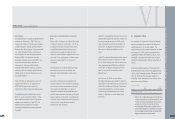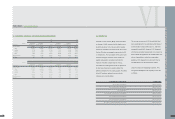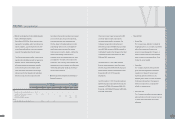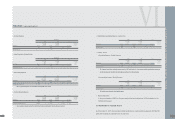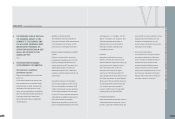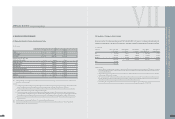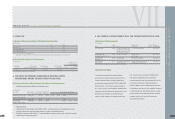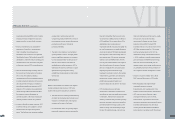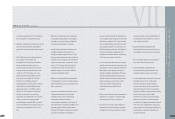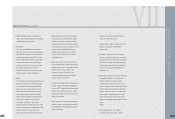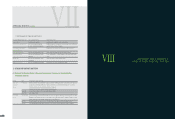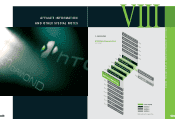HTC 2007 Annual Report Download - page 104
Download and view the complete annual report
Please find page 104 of the 2007 HTC annual report below. You can navigate through the pages in the report by either clicking on the pages listed below, or by using the keyword search tool below to find specific information within the annual report.
202
AN OVERVIEW OFTHE COMPANY'S FINANCIAL STATUS
203
mail-in rebate are made according to contract
stipulations and other related factors and
recognized as marketing fees, and are
entered as fees or deductions from revenue
depending on their category.
> R
e
s
e
rv
e
f
or w
a
rr
a
n
t
y
e
xp
e
ns
e
s
HTC provides a one- to two-year period of
free warranty maintenance in after sales
service. It makes reasonable estimates of
possible amounts for that service and
recognizes warranty liabilities based on
historical experience and other relevant
factors. Due to the gradual increase in own-
brand business, allocations to the product
warranty reserve have been increased and
now stand at about 4% of revenue.
6. THE COMPANY SHOULD DISCLOSE
THE
F
INANCIAL IMPACT TO THE
COMPANY I
F
THE COMPANY AND
ITS A
FF
ILIATED COMPANIES HAVE
INCURRED ANY
F
INANCIAL OR
CASH
F
LOW DI
FF
ICULTIES IN 2007
AND AS O
F
THE DATE O
F
THIS
ANNUAL REPORT
:
None.
7. OTHER MATTERS REQUIRING
SUPPLEMENTARY EXPLANATION
:
EXPLANATION O
F
SIGNI
F
ICANT
ACCOUNTING POLICIES
:
>
F
i
n
a
n
c
i
a
l
a
ss
e
t
s/
li
a
b
ili
t
i
e
s
a
t
f
a
i
r v
a
l
u
e
t
hrough
pro
f
i
t
or
l
oss
The financial products whose change in fair
value is recognized in earnings are forward
foreign exchange contracts. Because of the
small differences in buying prices, selling
prices, and mid-market prices, estimated fair
value for outstanding contracts at period end
is generally based on the public market
quotes of financial institutions (usually the
mid-market price).
> Av
a
il
a
b
l
e
-
f
or-s
a
l
e
f
i
n
a
n
c
i
a
l
a
ss
e
t
s
The available-for-sale financial assets are
listed stocks. Estimates of fair value are based
on the closing price for exchange- or OTC-
listed securities on the balance sheet date.
> R
e
v
e
nu
e
r
e
c
ogn
i
t
i
on
a
nd
a
ll
ow
a
n
c
e
f
or doub
tf
u
l
a
cc
oun
t
s
Revenue is measured at fair value as the
transaction price agreed between HTC and
buyers (considering trade discounts and
volume discounts). As HTC operations have
shifted toward primarily non-ODM work,
added trade discounts have included price
protection, marketing development fund, and
mail-in rebate.
Assessment of allowance for bad debt is
based on age analysis of accounts. Factors
such as recoverability of receivables, credit
ratings, and the overall economic climate are
used in regular assessments of receivables
recovery. HTC gives customers rankings and
makes allocations at different rates based on
their financial condition; reasonable
allowances are provided for customers with
good credit standing according to their period
of delinquency, i.e., 31 to 60days, 61 to 90
days, 91 to 120 days, and 120 days or more.
Individual determinations are made for
customers with poorer credit, as well as
reasonable estimates of allowances for
receivables not yet due.
> Inv
e
n
t
or
i
e
s
Assessments of allowances for loss on
decline in inventory value or loss on items
retired are based on analysis of inventory age
and of slow moving or obsolete inventory
items. Allowances of 25% to 75% are
allocated for items with 60-180 days in
inventory and 100% for items above 180
days; allocations are made at various rates for
other items depending on inventory category.
Allowances of 100% are allocated for items in
the final stage of their product life cycle and
with no market value due to changes in
economic conditions (such as legal orders
requiring products be made lead-free).
> A
cc
ru
e
d m
a
r
k
e
t
i
ng
e
xp
e
ns
e
s
Reasonable estimates for amounts of fees for
marketing and trade discounts such as price
protection, marketing development fund, and
VI
FINANCEI SUPPLEMENTARY EXPLANATION
l



